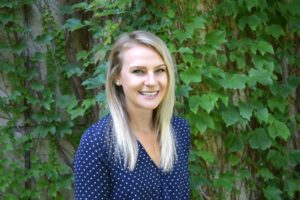
Charlene Van Buiten is an assistant professor in the Department of Food Science and Human Nutrition at Colorado State University. Learn more about why she came to CSU and her research interests in plant-based nutrition.
1. What brought you to the Department of Food Science and Human Nutrition at CSU?
It has always been my goal to pursue research and teach at an institution which recognizes and values the innate relationships between food, nutrition and the world at large. The fact that food science and nutrition are studied in the same department at CSU makes it the perfect home for my research, and CSU’s dedication to the Land Grant Mission of making education accessible and relevant to the public makes CSU an excellent personal fit as well.
2. What are your research interests, and how did you get into that topic?
I am interested in the biochemical functionality of plant-based foods in treating chronic inflammatory diseases of the gastrointestinal tract, and exploring how processing can be used to enhance their health benefits. I became interested in food science as a high school student participating in my local Future Farmers of America chapter, then went on to earn my Bachelor of Science in nutritional sciences at the University of Connecticut. I fell in love with food chemistry research while working on a project related to meat color at University of Connecticut, but I turned my attention to plant foods soon after. While completing my doctoral studies at Penn State, I developed a nutraceutical approach for treating celiac disease using compounds found in tea and other plant-based foods. I then continued to pursue my interest in health-promoting plant compounds during a postdoctoral fellowship in botanical medicine at Rutgers University before coming to CSU.
I find plant foods to be fascinating because they’re so dynamic as raw materials- the phytochemical makeup of a plant food can be affected by everything from growing conditions in the field to how it’s prepared in your kitchen. The ability to manipulate these characteristics can be troublesome when they’re relied on for health benefits, and it’s difficult to make recommendations if you don’t know exactly what you’re getting each time. Furthermore, there is also a challenge in balancing the preservation or enhancement of health benefits with the potential impact on quality parameters such as how a product looks, smells or tastes.
3. What is your teaching philosophy?
Food science is an interesting field to teach because a good food scientist is really a jack of all trades, applying concepts from from different fields—chemistry, microbiology, engineering—to solve problems related to food. In the real world, this often takes some creativity as well. With rapid advancement in technology and an increasingly globalized food supply, students need to be ready to excel in jobs that might not even exist yet. I believe that it’s my responsibility not only to help transfer knowledge to students, but to provide opportunities to apply this knowledge through activities such as developing and testing food products, writing and presenting research proposals, or creatively troubleshooting existing issues in food processing.
4. What’s your favorite thing about campus?
I’m really impressed by CSU’s commitments to sustainability, which are visible in all facets of campus life from recycling and compost bins to the designated bike lanes. Also, I don’t think I’ll ever get tired of our view of the foothills!
The Department of Food Science and Human Nutrition is part of the College of Health and Human Sciences.